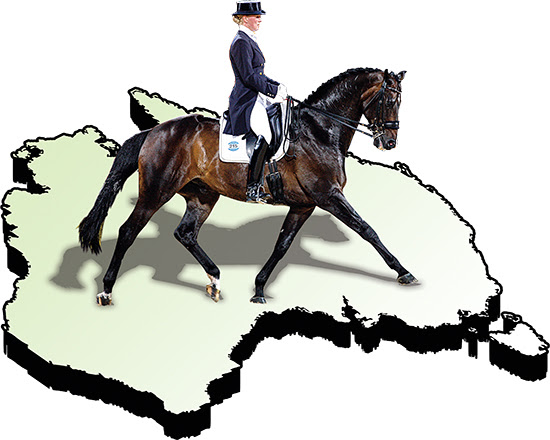
Danish Delight – Princess Nathalie Down Under

Fresh from her Olympic campaign, Princess Nathalie of Denmark recently hosted a series of dressage clinics in Australia, in Queensland and NSW with the last clinic being held in Victoria at Danielle Harvey’s Officer property, Jesmond Dene. The thirty-three year old princess, who is Crown Prince Frederick’s cousin, won bronze in Hong Kong at the recent Beijing Olympic Games in the team dressage. She has trained extensively with Kyra Kyrklund and former German Team Coach Klaus Balkenhol.
An unassuming Princess Nathalie is first seen by us, casually eating a sandwich as we walk in. Dressed in jeans and a green horse jacket she looks like any other Australian dressage enthusiast, except for that very Scandinavian blonde hair…and the pictures pinned on the arena wall by a proud organizer (and Danish patriot) Pernille Hogg, of Princess Nathalie with her bronze medal.
The first horse we see is by Ferro, and is a big, black, flashy gelding, ridden by Monica Bird. The Flowervale Warmblood Stud bred the cute eight-year-old, Flowervale Ferro II, and Lauren Robson from the stud is in attendance proudly watching this very attractive horse work.
Monica gives the horse a quick warm up then Princess Nathalie walks onto the arena. After a brief chat and a pat on the nose for the little Ferro, they begin. Princess Nathalie immediately notices that the horse is not carrying himself correctly and needs to be straighter, with more impulsion and less speed. She really focuses on Monica’s position, asking her to sit her weight on her seat-bones and to focus on feeling her body keep with the rhythm of the horse, not working against it.

Straightness is very important to the Princess, and is focused on in later lessons as well. The horse is bulging on the circle and Monica has to really work to keep his outside shoulder on the circle and his hindquarters in line with the rest of his body.
Princess Nathalie tells Monica that “the left hand balances the left shoulder, the right hand balances the right shoulder”, and that the horse is not “allowed to balance himself on your hands, you’re only allowed to have the shoulders on your hands.” This is something Nathalie worked on when training with Kyra Kyrklund.
They begin with lots of little transitions to get the hindquarters working underneath the horse and the weight off her hands. “If he gets heavy on the outside rein, little half halt with inside rein, but keep him straight, and halt. He has to wait for you. Keep both shoulders in your hands, making a tunnel through your hands, and you want to keep his shoulders in that tunnel.”
The Princess is a very “teachy teacher”, giving detailed explanations of what is wanted, making sure Monica understands, using her body to demonstrate not only how the rider should be moving, but the horse as well. There is a sense of understanding from the Princess, that she knows what it means to train the horses and ride them each day. When talking about the position of the rider she tells Monica to relax her body and sit on his hind legs, as the horse is not allowed to move away from her weight, “it’s logical, but not easy. I know that. It’s taken me a while to realise that.” The concept of the rider balancing herself on the horse’s hindquarters is emphasised and Monica is repeatedly told to ‘stay sitting’ until the horse has “put his hind legs under your seat. Once he stays there you can ride him bigger.”
When the horse bulges through the corners the Princess tells Monica that she has to “feel his shoulders between her hands and knees,” that she is driving the horse through the tunnel and he cannot move outside that tunnel. “The horse needs to have his weight on his hindquarters so that you can move his shoulders anywhere you want to, if his weight is on his shoulders you cannot move them.”
The Princess emphasises the lower leg position, telling Monica not to take the leg so far back, but to keep it on the girth as the further back it goes, the more you tip forward, making you lose balance and lose your position on his hindquarters. “He is not allowed to swizzle off behind you and then go behind your leg.”
As the corrections are made the horse begins to move forward and sit on his hind legs, but then Nathalie focuses on the horse’s head position. He is coming slightly behind the bit, and the Princess tells Monica to “let him go slightly longer – he’s not allowed to hang down there – just so that he arches through your hand. You don’t want him to shorten and quicken, you want him slightly longer in the neck as it is easier for him to push off.” It is the same in canter, “don’t let him go short in the neck and hollow his back – longer – go back to trot without shortening the neck, he can’t lose that long neck.”

By the end of the lesson Monica has him working much better and riding ‘through the tunnel’ which the Princess described











